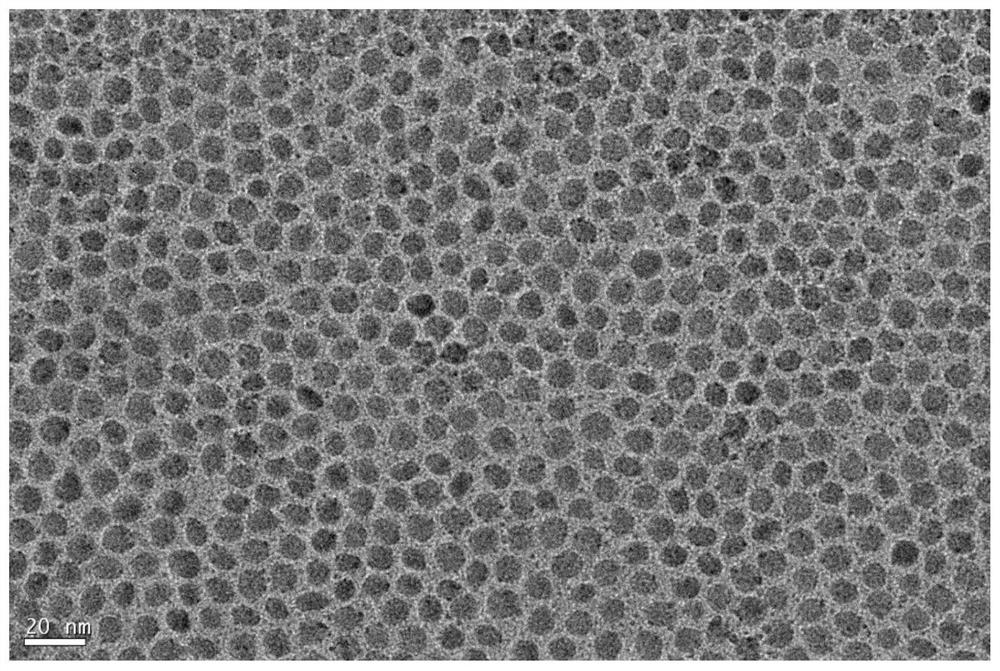Up-conversion super-resolution imaging nanoprobe and its preparation method and application
A super-resolution imaging and nanoprobe technology, applied in the field of fluorescence microscopy and immunofluorescence, can solve the problems of easy photolysis and photobleaching, long-term observation of unfavorable biological samples, poor photochemical stability, etc. No photobleaching, good photochemical stability, and large anti-Stokes shift
- Summary
- Abstract
- Description
- Claims
- Application Information
AI Technical Summary
Problems solved by technology
Method used
Image
Examples
Embodiment 1
[0049] see figure 1 In this example, the synthesis, carboxyl modification and optical loss methods of the up-conversion super-resolution imaging nanoprobe are mainly explained. Specifically, the following steps are included:
[0050] 1. The method (solvothermal method) of synthesizing up-conversion nanoparticle, concrete steps are as follows:
[0051] (1) Synthesis of super-resolution upconversion nanoparticle core structure:
[0052] In the oleic acid / 1-octadecene (v:v=8:15, unit: mL) system, add 5ml of 0.2mol / L (n=1mmol) Ln(CH3CO2)3(Ln=Y:Yb:Tm =74:18:8) solution. Expose and heat to 150°C, and stir for 40 minutes. After cooling down to room temperature, 10ml 0.4mol / L NH4-methanol solution and 2.5ml 1mol / L NaOH-methanol solution were added dropwise, and the water bath was kept at 40°C and stirred for 2h. Then the water bath was removed, and the system was heated to 100°C and vacuumed for 30 minutes to completely remove methanol. After the vacuuming was completed, the temp...
Embodiment 2
[0063] Applying the up-conversion super-resolution imaging nanoprobe described in Example 1 to fluorescence super-resolution imaging, the following imaging method can be used: the near-infrared depleted light is modulated into a hollow beam with a spatial phase modulation plate, and collimated with the excitation beam. After yoke focusing, rare earth-doped upconversion nanoparticles and their labeling are applied to cell immunofluorescence imaging. Based on this microscopic imaging method, a super-resolution optical microscopic imaging system consisting of an excitation light generation module, a loss light generation module, a dichroic mirror, a multiphoton microscopic scanning module and a photodetection module is built on the basis of existing technologies , to obtain low-cost, low-complexity, high-resolution, simple and effective real-time dynamic three-dimensional images.
[0064] This embodiment specifically describes a super-resolution optical microscopy imaging system ...
Embodiment 3
[0072] In this example, the specific immunolabeling method of the up-conversion super-resolution imaging nanoprobe modified by the primary antibody is illustrated: for example, the primary antibody protein (anti-desmin protein primary antibody , desmin protein is a modification of cytoskeleton protein) for cytoskeleton-specific immunolabeling, and then super-resolution imaging of cytoskeleton:
[0073] (1) Carboxylated up-conversion super-resolution imaging nanoprobes are modified with primary antibodies, and the specific steps are as follows:
[0074] Take 1ml of 1mg / ml UCNPs-COOH, add 20μl of 0.3mg / μl NHS and 20μl of 0.2mg / μl EDC to it and stir at room temperature for two hours. Collect by centrifugation at 15,000rpm for 30min, and dissolve with 1ml deionized water. The pH was adjusted to 7.2-7.5, and 100 μl of the primary antibody of the antibody was added to prepare the primary antibody-modified up-conversion super-resolution imaging nanoprobe.
[0075] (2) The primary a...
PUM
| Property | Measurement | Unit |
|---|---|---|
| particle diameter | aaaaa | aaaaa |
Abstract
Description
Claims
Application Information
 Login to View More
Login to View More - R&D
- Intellectual Property
- Life Sciences
- Materials
- Tech Scout
- Unparalleled Data Quality
- Higher Quality Content
- 60% Fewer Hallucinations
Browse by: Latest US Patents, China's latest patents, Technical Efficacy Thesaurus, Application Domain, Technology Topic, Popular Technical Reports.
© 2025 PatSnap. All rights reserved.Legal|Privacy policy|Modern Slavery Act Transparency Statement|Sitemap|About US| Contact US: help@patsnap.com



